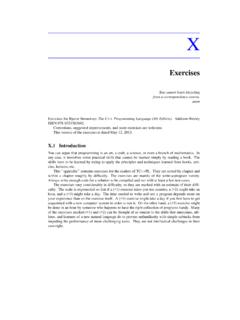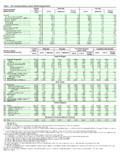Transcription of An Overview of the C++ Programming Language
1 FromThe Handbook of Object Technology (Editor: Saba Zamir). CRC Press LLC, Boca Raton. 1999. ISBN Overview of the C++ Programming LanguageBjarne StroustrupAT&T LaboratoriesFlorham Park, NJ07932-0971, USAABSTRACTThis Overview of C++presents the key design, Programming , and Language -technical con-cepts using examples to give the reader a feel for the Language . C++is a general-purposeprogramming Language with a bias towards systems Programming that supports efficientlow-level computation, data abstraction, object-oriented Programming , and generic Introduction and OverviewThe C++ Programming Language provides a model of memory and computation that closely matches that ofmost computers. In addition, it provides powerful and flexible mechanisms for abstraction; that is, lan-guage constructs that allow the programmer to introduce and use new types of objects that match the con-cepts of an application.
2 Thus, C++supports styles of Programming that rely on fairly direct manipulationof hardware resources to deliver a high degree of efficiency plus higher-level styles of Programming thatrely on user-defined types to provide a model of data and computation that is closer to a human s view ofthe task being performed by a computer. These higher-level styles of Programming are often called dataabstraction, object-oriented Programming , and generic paper is organized around the main Programming styles directly supported by C++: 2 The Design and Evolution of C++describes the aims of C++and the principles that guided its evolu-tion. 3 The C Programming Modelpresents the C subset of C++and other C++facilities supporting tradi-tional systems- Programming styles. 4 The C++Abstraction Mechanismsintroduces C++ s class concept and its use for defining new typesthat can be used exactly as built-in types, shows how abstract classes can be used to provide inter-faces to objects of a variety of types, describes the use of class hierarchies in object-oriented pro-gramming, and presents templates in support of generic Programming .
3 5 Large-Scale Programmingdescribes namespaces and exception handling provided to ease the com-position of programs out of separate parts. 6 The C++Standard Librarypresents standard facilities such as I/O streams, strings, containers ( ve ec ct to or r,l li is st t, andm ma ap p), generic algorithms ( so or rt t(),f fi in nd d(),f fo or r_ _e ea ac ch h()) and support fornumeric round off, a brief Overview of some of the tasks that C++has been used for and some suggestions forfurther reading are The Design and Evolution of C++C++was designed and implemented by Bjarne Stroustrup (the author of this article) at AT&T Bell Labora-tories to combine the organizational and design strengths of Simula with C s facilities for systems pro-gramming. The initial version of C++, called C with Classes [Stroustrup,1980], was first used in 1980;it supported traditional system Programming techniques ( 3) and data abstraction ( ).
4 The basic facili-ties for object-oriented Programming ( ) were added in 1983 and object-oriented design and pro-gramming techniques were gradually introduced into the C++community. The Language was first madecommercially available in 1985 [Stroustrup,1986] [Stroustrup,1986b]. Facilities for generic Programming ( ) were added to the Language in the 1987-1989 time frame [Ellis,1990] [Stroustrup,1991].As the result of widespread use and the appearance of several independently-developed C++- 2 -implementations, formal standardization of C++started in 1990 under the auspices of the AmericanNational Standards Institute, ANSI, and later the International Standards Organization, ISO, leading to aninternational standard in 1998 [C++,1998]. During the period of standardization the standards committeeacted as an important focus for the C++community and its draft standards acted as interim definitions ofthe Language .
5 As an active member of the standards committee, I was a key participant in the further evolu-tion of C++. Standard C++is a better approximation to my ideals for C++than were earlier versions. Thedesign and evolution of C++is documented in [Stroustrup,1994] [Stroustrup,1996] and [Stroustrup,1997b].The Language as it is defined at the end of the standardization process and the key design and programmingtechniques it directly supports are presented in [Stroustrup,1997]. C++Design AimsC++was designed to deliver the flexibility and efficiency of C for systems Programming together withSimula s facilities for program organization (usually referred to as object-oriented Programming ). Greatcare was taken that the higher-level Programming techniques from Simula could be applied to the systemsprogramming domain. That is, the abstraction mechanisms provided by C++were specifically designed tobe applicable to Programming tasks that demanded the highest degree of efficiency and aims can be summarized:_ _____Aims:_ _____ _____C++makes Programming more enjoyable for serious ++is a general-purpose Programming Language that is a better C supports data abstraction supports object-oriented Programming supports generic programming_ _____ Support for generic Programming emerged late as an explicit goal.
6 During most of the evolution of C++, Ipresented generic Programming styles and the Language features that support them ( ) under the headingof data abstraction. Design PrinciplesIn [Stroustrup,1994], the design rules for C++are listed under the headingsGeneral rules,Design-supportrules, Language -techn ical rules, andLow-level Programming support rules:_ _____General rules:_ _____ _____C++ s evolution must be driven by real ++is a Language , not a complete t get involved in a sterile quest for ++must be feature must have a reasonably obvious provide a transition comprehensive support for each supported t try to force _____ Note the emphasis on immediate utility in real-world applications and the respect for the skills and prefer-ences of programmers implied by the last three points. From the start, C++was aimed at programmersengaged in demanding real-world projects.
7 Perfection was considered unattainable because needs, back-grounds, and problems vary too much among C++users. Also, notions of perfection change significantlyover the lifespan of a general-purpose Programming Language . Thus, feedback from user and implementerexperience is essential in the evolution of a 3 -_ _____Design-support rules:_ _____ _____Support sound design facilities for program what you features must be is more important to allow a useful feature than to prevent every composition of software from separately developed _____ The aim of C++was to improve the quality of programs produced by making better design and program-ming techniques simpler to use and affordable. Most of these techniques have their root in Simula[Dahl,1970] [Dahl,1972] [Birtwistle,1979] and are usually discussed under the labels of object-orientedprogramming and object-oriented design.
8 However, the aim was always to support a range of design andprogramming styles. This contrasts to a view of Language design that tries to channel all system buildinginto a single heavily supported and enforced style (paradigm)._____Language-technical rules:_____No implicit violations of the static type as good support for user-defined types as for built-in is order in doubt, pick the variant of a feature that is easiest to matters (often in perverse ways).Preprocessor usage should be These rules must be considered in the context created of the more general aims. In particular, the desire fora high degree of C compatibility, uncompromising efficiency, and immediate real-world utility counteractsdesires for complete type safety, complete generality, and abstract Simula, C++borrowed the notion of user-defined types (classes, ) and hierarchies of classes( ).
9 However, in Simula and many similar languages there are fundamental differences in the supportprovided for user-defined types and for built-in types. For example, Simula does not allow objects of user-defined types to be allocated on the stack and addressed directly. Instead, all class objects must be allo-cated in dynamic memory and accessed through pointers (calledreferencesin Simula). Conversely, built-in types can be genuinely local (stack-frame allocated), cannot be allocated in dynamic memory, and cannotbe referred to by pointers. This difference in treatment of built-in types and user-defined types had seriousefficiency implications. For example, when represented as a reference to an object allocated in dynamicmemory, a user-defined type such asc co om mp pl le ex x( ) incurs overheads in run-time and space that weredeemed unacceptable for the kind of applications for which C++was intended.
10 Also, the difference in styleof usage would preclude uniform treatment of semantically similar types in generic Programming ( ).When maintaining a large program, a programmer must invariably make changes based of incompleteknowledge and looking at only a small part of the code. Consequently, C++provides classes ( 4), name-spaces ( ), and access control ( ) to help localize design order dependencies are unavoidable in a Language designed for one-pass compilation. For exam-ple, in C++a variable or a function cannot be used before it has been declared. However, the rules for classmember names and the rules for overload resolution were made independent of declaration order to mini-mize confusion and _____Low-level Programming support rules:_ _____ _____Use traditional (dumb) gratuitous incompatibilities with no room for a lower-level Language below C++(except assembler).















